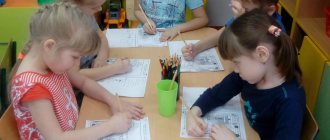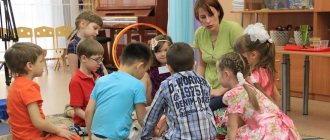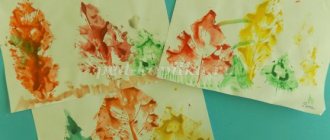The Hungarian psychologist and teacher has developed wonderful exercises and games that promote the development of mathematical concepts, as well as creative and logical thinking. Work on getting to know blocks begins in the second junior group, where kids identify one feature of an object. In the middle group, the tasks become more complicated, symbol cards appear, with the help of which children select the necessary figures. What games can be used with Dienesh blocks in older preschool age?
Games with Dienesha blocks in older preschool age
Children of senior preschool age are able to operate with several properties of an object at once. Children have developed imaginative thinking and are able to solve riddles, read symbols, engage in encoding and decoding. Preschoolers enjoy playing and doing exercises with Dienesh blocks. [ads1]
Game "Guess the riddle"
On a field of 4 or 5 parts, depending on the level of preparedness of the children, symbols of the figures are laid out, while the last window remains for guessing. For example, we put signs on the field: thin yellow and triangular. The child must place a thin yellow triangle in the empty window, and the size of the figure is not taken into account. You can make riddles from four symbols, for example: circle, thick, large, blue. In response, the child will put a blue, large, thick circle. The most difficult version of this game is with the negation of 1, 2, or 3 signs. The opposite game, “Make a Riddle,” is an empty tablet on which children, having chosen a figure, place the corresponding signs.
Educational game “Settling the Tenants”
The game “Settle the Tenants” is very exciting and students can play it in whole groups, and then test each other. In each apartment you need to place a tenant based on his characteristics (color, shape, size and thickness). For example, on the first floor there lives a blue, fat tenant, and on the second there is a red, not fat, but square tenant, on the third - not blue, rather large, round and thin. The houses are designed for children with different levels of preparedness, where it is necessary to take into account 2-4 signs and use negatives.
Educational game "Labyrinth"
Children happily respond to games like “Labyrinth”, “Tree”, etc., where they must find a place for their figure. Such games are aimed at developing the ability to classify blocks according to three characteristics and the ability to identify the main characteristics. Draw a tree with branches of different colors without leaves. Each branch has its own symbol indicating shape, size or thickness.
The child with the red large triangle must find a red branch with the “triangle and large” icon (or not a square, large, or a triangle, not small, etc.). It all depends on the level of development of the children and the creativity of the teacher. You can draw labyrinths, roads to garages, garden beds, and encode all information with icons. Such games bring great pleasure to children, and knowing about the “discoverer instinct”, you can achieve great results.
Educational game "Round Dance"
On winter evenings, and even on hot summer evenings, you can play dominoes or do round dances. To do this, divide all the blocks between the children and agree on the rules. The first player places any piece, and the next player must put a piece of a different size, or the same shape, but a different color, or a different shape, but the same size and thickness, etc. Children can come up with rules, and the teacher carefully monitors their implementation.
From the “ammunition depot” to the children’s playroom
It's no secret that educational games are required at every stage of a child's development. And parents are always very concerned about how to choose the most useful thing. As a result, the children's room turns into a kind of museum, or into some kind of “ammunition warehouse” for the child’s development.
And a child, overwhelmed with these educational toys, does not show any interest in them. Parents get upset, apparently decide that they did not choose the best benefit, and buy new ones - even more interesting.
In the best case, the child plays for a month or two, and soon it again becomes unimportant, uninteresting and irrelevant.
In fact, everything is much nicer and simpler. A small amount of aids and toys is enough to enable you to develop your child throughout the entire period of preschool and primary school age.
After all, with a creative approach, if you want to grow with your child, if you want to play with him and get joy from the educational process, you can come up with a lot of interesting games at every age.
This will help protect the parent’s wallet, and of course, develop your child. Because a child who knows how to manipulate the same object in different ways is more mature in an intellectual sense.
Today, using the example of a manual, we will talk about how you can, starting from literally six months and ending with the third or fourth grade, raise a child on one benefit and develop, by the way, together with him, because some tasks are difficult even for adults.
Games with hoops and Dienesha blocks
A special section in Dienesh’s methodology is devoted to games with hoops, which also begin with completing simple tasks and gradually become more complex, allowing the teacher to develop analytical thinking, mental flexibility and speed of reaction in future schoolchildren.
"Game with one hoop"
There is a hoop on the floor. Each child has one block in his hand. Children take turns placing blocks in accordance with the leader’s instructions. For example, inside the hoop are all red blocks, and outside the hoop are all the rest. Children are asked questions: What blocks are inside the hoop? (Reds). Which blocks were outside the hoop? (Non-red). This is the correct answer, because... the only important thing is that all the red blocks are inside the hoop and there are no others there, and the properties of the blocks outside the hoop are determined through the properties of those that lie inside. When repeating the game, children can choose for themselves which blocks to put inside, outside, and then determine to each other in one word the shapes outside the hoop.
"Game with two hoops"
There are two multi-colored hoops on the floor (blue and red), the hoops intersect, so they have a common part. The presenter invites someone to stand inside the blue hoop, inside the red hoop, inside both hoops, outside the red hoop, inside the blue but outside the red, inside the red but outside the blue, outside the blue and red hoops.
Then the children arrange the blocks so that all the round blocks are inside the blue hoop, and all the red ones are inside the red hoop.
At first, the problem is where to put the red and round blocks. Their place is in the common part of the two hoops. After completing the practical task of arranging blocks, children answer four questions:
- What blocks are inside both hoops?
- Inside the blue but outside the red hoop?
- Inside red but outside blue?
- Outside both hoops?
It should be emphasized that the blocks must be named here using two properties - shape and color.
"Game with three hoops"
During the game with three hoops, the task of classifying blocks according to three properties is solved, which is more complex than in the game with two hoops. The presenter places three multi-colored (red, blue, yellow) hoops on the floor as shown in the figure, i.e. to form 8 regions.
Once these areas are named appropriately in relation to the hoops (inside all three hoops, inside red and blue, but outside yellow, etc.), it is proposed to arrange the blocks, for example, so that all the red blocks are inside the red hoop, inside the blue they are all square, and inside the yellow they are all big.
After completing the practical task, children answer eight questions (standard for any version of the game with three hoops).
- What blocks are inside all three hoops?
- What blocks are inside the red and blue hoop, but outside the yellow hoop?
- What blocks are inside the blue and yellow hoop, but outside the red hoop?
- What blocks are inside the red and yellow hoop, but outside the blue hoop?
- What blocks are inside the red hoop, but outside the blue and outside the yellow hoop?
- What blocks are inside the blue hoop but outside the yellow and red hoop?
- What blocks are inside the yellow hoop, but outside the red and outside the blue hoop?
- Which blocks are outside all three hoops?
The game with three hoops models the partition of a set into eight classes (pairwise disjoint subsets) using three properties (being red, being square, being large). [ads2] Games with Dienesh blocks in older preschool age do not require special preparation, you only need to prepare special cards for joint and individual work. You can download an archive with cards for games with Dienesh blocks, which contains symbol cards and negation cards, as well as cards for the games “Guess the Riddle”, “Rest the Tenants”, “Logic Tables” of different difficulty levels.
Even more games
Along with the blocks, you can use the “Let's Play Together” manual, which continues and deepens the work on the Dienesh system. It includes:
- cards with conventional images of features of figures or denial of their properties, 11 confirming the feature (round), and 11 denying (not red). They help in mastering such abstract concepts for children as signs.
- 9 groups of figures, each of which consists of 24 pieces;
- logic cubes - 5 with property symbols and one with numbers, form the child’s skills such as coding and decoding.
Using logical blocks together with a set of cards, you can create about 20 different game plots. Here are just a few of them.
Game "In the store"
The set also contains sheets with drawn toys from playing figures. The baby is given “money” (blocks) with which he can buy toys for himself. But this can be done in such a way that the existing block and the figures in the image have at least one common feature. For example, for a red triangle you can buy a house or an animal with triangular ears.
"Logic Train"
The application provides several trains, each with its own color, assigned number and four carriages. Children place cards above their carriages with the indicated algorithm for changing the characteristics of the figures and select the corresponding blocks. For example, if you can change the shape and color, then a red round weight will become a yellow square one.
Other development systems:
- Makoto Shichida technique
- Cuisenaire counting sticks
Among the worksheets in the “Let's Play Together” set, there are also those that represent algorithms. You can play “architects” with them, creating a playground project or decorating a Christmas tree according to the pattern.
Getting ready for school
After three-year-olds, gradually complicating and complicating the tasks, we approach children who are “preparing” for school, children of six or seven years old
. It is very important for them to develop logical thinking and build conceptual series.
Together with the children, we will be able to build so-called logical chains, when we select and change figures in accordance with some task.
And it’s good if we can calculate what the figure was at the beginning, if we started from a circle, and then we should come to, say, a rectangle. From the big they must come to the small; from the thick we must come to the thin - how many stages do we need to go through in order to build this path? Or vice versa, we all went from a circle, and by changing one category, freely creating, everyone will get their own result.
This moment of developing logic, attention, and concentration is exactly what future first-graders need, and teachers should hear it. Because there is only one teacher, and there are thirty people in the class. It is important for children to catch this thought, hold it in their heads and convey it until they get the result, and then evaluate their result.
I would also like to say that the manuals are so comfortable to use that you can work with them absolutely anywhere.
.
It doesn't have to be done as an academic assignment while sitting at your desk. You can run with them, you can scatter them, collect them, sort them, mix them and thus compensate for
For children of all ages, it is worth including active games
. As for preschoolers, this is simply necessary. For example, the game “the store opens - the store closes.” The store opens - we have a bunch of these blocks that attract with their diversity, and the seller can only sell goods of one category: you can only take the thick ones.
For older children, we can include the “quantity” category in the game: you can only take three thick figures, and preferably all of them are of different colors. And so on, complicating and complicating ad infinitum
. From blocks selected according to various criteria, you can build, for example, a house, and from small parts you can make a garden.
Field for imagination
In order not to get bored - after all, any thing gets a little boring - you can add absolutely any scenarios.
For example, build baskets and put wooden fruits in them - that's what you have, or real fruits, and then have fun crunching them. You can take various interesting animals and build different ships for them. And these animals will travel with us. Don't be afraid to create, don't be afraid to experiment.
If your cubes are not wooden, then you should try to compensate for this with different materials. The materials are all different in texture: very noisy, ringing plastic; and a wonderful tree; and everyone’s favorite glass – heavy, smooth, noisy; and wonderful bright multi-colored buttons.
This is the universality of the aids - the principle that you can use whatever is at hand to play. Moreover, if you do not have the opportunity to buy a manual, you can open a page on the Internet and see the entire list of materials.
You can, if you don’t have wood, glue them together from cardboard and create this educational set for your child, so universal that you can go with it into a long life as a researcher of physical phenomena and a young conqueror of interesting mathematical tasks.
A matter of choice
When children get older, we can come up with different games, and then plush toys come to the aid of little children - our furry friends, whom we can feed, dress, with whom we can go for walks and jump in puddles.
And then come up with actions with the figures from the set - say, imagine that these are pieces of soap with which we will wash them, and at the same time, very carefully, in the game, give the kids different concepts: division by color, division by shape.
Understanding that there are different figures, and one of the most difficult moments is understanding that you need to take a
different figure .
For example, not blue or red - but then which one? For example, not big - but then which one?
And if it is not blue and not big, then it turns out to be a complex riddle. And all the time you need to create a search situation. And then the child will have both interest and desire to develop.
When working with young children, do not demand from them perseverance and composure beyond their age.
The main thing is that all participants have fun.
The youngest children can concentrate for only a few minutes. That is, if your baby sorted through these objects for three to five minutes, consider that your lesson was completed.
Older children can already play for about ten minutes. But again, everything will depend on your desire to play. If your eyes are burning and you always want to come up with new things, then your lesson with three-year-old children can last half an hour. And you will be happy to discover new stories with them.
Help with your studies
Thus, switching of attention and, of course, logic develop. That is, this is what most parents are probably chasing now - that is, the development of intelligence
. This is how it is safe to develop intelligence; we will not overload the child. Because when the child gets tired, he simply will not be able to compare anything, and we will understand that we have overextended ourselves a little with this task.
You should always end when there is still great interest
, do not be afraid to interrupt the lesson at the most interesting moment. And then the child will wait for the next lesson, will run, hurry, and not necessarily try to reach some point, necessarily draw some conclusion. This is not always important. Sometimes it is more important to maintain interest in learning.
Can Dienesh Blocks also serve a child during school years? Of course yes.
There are so many tasks with them that even adults can use their brains, and for children the choice of tasks and game scenarios is almost inexhaustible.
Of course, surprise arises: how is it that the same allowance is given to six-month-old and nine-year-old children?
In fact, the same logical concepts, the same logical chains in a more complicated version, of course, are of great interest to children of primary school.
As part of the school curriculum, the teacher does not have the opportunity to fully reveal these concepts and practice many logical conclusions with children.
These manuals allow, if you are an organized parent, to carry out project activities - write a project that you will build.
Analyze, make a list of the materials you need, select them, then build what you expected and evaluate whether the resulting result corresponds to the project you were building.
And this activity, firstly, can attract several children of different sexes, and there is an interesting story for each
. And this story can last several days, it can take, say, Saturday and Sunday, when the weather is rainy, and you can unite with several families and build entire cities, entire planets, ships, and go on an interesting journey in search of new knowledge and discoveries.
Simple, at first glance, tasks with “Dyenesh Blocks” can baffle anyone. After all, some games require you to quickly make a choice using logic.
And if there are certain difficulties at different ages, which indicate that logical thinking is not sufficiently developed, then one should not be afraid to step back a few steps, one should not be afraid to give a task that is too simple to the child. It is very important and this is what needs to be done.








